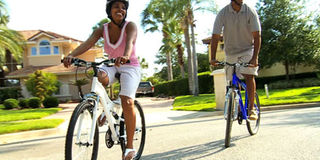Staying safe while riding

Wearing protective gear such as a helmet is a must. Shutter Stock Photo
What you need to know:
During this time when private cars have been banned, riding has been adopted by many as a way to get from one point to the next. However, even the most casual bicycle ride has you travelling at high speeds and, therefore, the need to protect yourself. These tips can help.
On April 17, I rode a bicycle from Kisaasi via the Northern Bypass to Namboole roundabout, through Kireka, Banda, Kyambogo, Nakawa, Namuwongo, Kololo, and back to Kisaasi through Bukoto and Ntinda.
Throughout the journey, I encountered motorists who are inconsiderate to other road users, especially cyclists. Since a number of people have taken to riding bicycles due to the ban on private vehicles, some safety precautions are listed below.
Ride at your pace
According to Alex Kasozi whose car is parked at home and now mostly moves by riding his bicycle from his home in Mutungo to his office in Bugolobi, both kampala suburbs, sometimes when you get on the road, you may feel as if you can ride at the same speed as cars.
“The braking efficiency of a car is totally different from that of your bicycle. With a bicycle, you need to ride as slowly as you possibly can because you cannot compete with cars. Riding at your pace allows you to control your bicycle,” Kasozi cautions.
Act like a pedestrian
Ronnie William Kyazze who also parked his cars since the lockdown started, advises that as you ride your bicycle, act as if you are a pedestrian by looking left and right and left again, especially if you get tired and are pushing the bicycle.
Use hand signals
Most, if not all bicycles do not have electronic indictors as cars. This means you ought to use hand signals to warn other road users, especially motorists when you intend to stop or make a turn.
And when you are stopping by the roadside, use your left hand to indicate left as you reduce speed and then place the left foot on the ground and alight or get off your bicycle from the left side of the road and not from the right.
Stop at junctions
Kyazze advises that before crossing at any junction with or without traffic lights, always stop and look to see if there are no vehicles coming from the left or right. This is because junctions are accident prone areas because of traffic conflicts that normally occur there. A traffic conflict is when two or more road users want to use the same road space at the same time. You should not only stop your bicycle completely at junctions but also at give way areas and stop signs.
Wear protective gears
Cycling protective gear include a cycling helmet that must have a lockable hook under your chin, gloves for holding onto the handlebars firmly to avoid developing bruises and comfortable shoes. You should also wear light coloured or fluorescent clothes for easy visibility.
Maintain cycling behaviour
You should not only avoid cycling on pavements but also practice good cycling habits such as keeping both hands on the handlebars except when signalling. Keep both feet on pedals but also avoid riding closely behind any vehicle. “When riding up the hill, do not gain support from any vehicle by touching on its sides or the rear. It compromises your visibility of other obstacles,” Kyazze says.
Avoid carrying heavy loads
If your bicycle has a carrier, do not carry anything heavier than what you can easily move around. It could even be a backpack. These will affect your balance on the bicycle and might lead to an accident. If you cannot ride any load, it is safer when you push the bicycle with the load tightly tied.
Look out for obstacles
Be on the lookout for loose gravel such as sand, puddles and other road hazards such as potholes or ditches. Slowing down should help you get through them safely.
“Be alert. Never ride with earphones or headphones plugged in your ears,” Kyazze advises.
Follow road markings and signs
Kasozi says you must know where you are riding to and mark road signs such as road lanes and traffic signs. Do not attempt to go when the lights are indicating red because you will be knocked by cars.
Must have items
Before you start riding, do not forget your mobile phone and identification card. If, God forbid, anything bad happens to you along the way, your identification will help emergency responders know who you are and how to help you.
Maintenance checks for bicycles
• Like your car, your bicycle must be well maintained. The handle bar must not only be tight and adjusted properly but the seat should be adjusted according to your height, with the feet being able to touch the ground.
• Brakes should be able to work perfectly well. The hind or rear brake should be used mostly because if you use the front one and you are riding fast, instant braking may lead to overturning, thus injuring yourself.
• Tyres must be well inflated and should also have treads. The bicycle horn or bell for hooting must also be functional. If your bicycle has a provision of changing gears, make sure the chain link is well oiled to avoid friction for easy gear engaging.
• If there is no need or urgency to ride your bicycle, please stay home.




